- HABITED (or HABILLÉ)
- The alternative heraldic terms used to describe the customary clothing (the "habit") of a
monk or friar – habillé – but see
vested (also
clad).
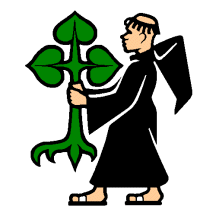
.gif)
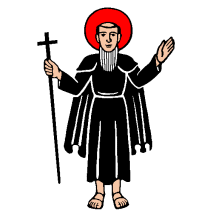
Flag of Münchenwiler, Switzerland;
Arms of Monaco;
Flag of Rieden, Switzerland
- HAFTED (or HAFT)
- The alternative heraldic terms used when the handle of a hammer or an axe/mace (or of a similar
tool/weapon) is of a different
tincture to its head – but see hilted (also
barbed,
garnished,
halberd,
ploughshare, shafted and
tincture).
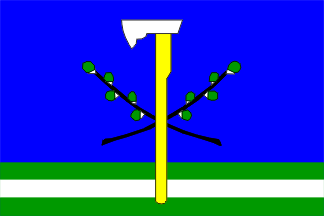
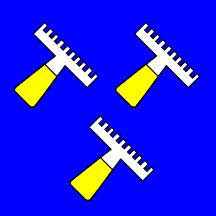
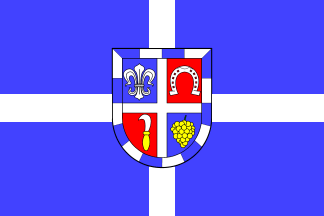
Flag of Lhota u Vsetína, Czechia;
Flag of Curtilles, Switzerland;
Flag of Edenkoben, Germany
- HALBERD
- A long-hafted Medieval weapon whose head consisted of a axe combined with a spear point and stabbing
blade (see also crossbow, hafted
and harnysed).
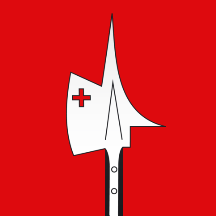
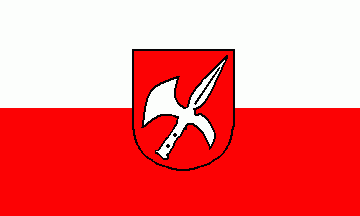
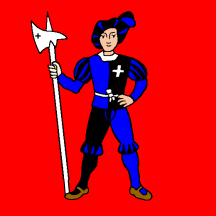
Flag of Neuwilen, Switzerland;
Flag of Hötensleben, Germany;
Flag of Tafers, Switzerland
- HALBRUNDSCHILD
- The German term for a round-bottomed shield – see Spanish-style shield.
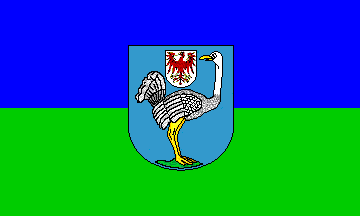
Flag of Strausberg, Germany
- HALF MAST (or HALF STAFF) A FLAG
- (v & adj) To fly a flag at a point below its normal position, with the upper edge
of the flag about a third of the length of the flag pole, or at least a flag’s width,
from the truck, as a sign of mourning (see also
dip, at the,
draping,
flag pole,
full mast,
length and
truck).

National Flag of the US at Half Mast (k326marines.com)
Please note that a flag should, if the proper
procedure is followed, be first raised right up to the truck before being
lowered to its half-mast position, and raised once again to the truck before
being lowered completely.
- HALF MOON
- A term sometimes (inaccurately) used in place of crescent – see crescent 1).

Flag of South Carolina, US
- HALO
- In heraldry see nimbus
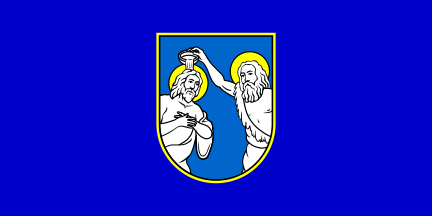
kc-ki.gif)
Flag and Arms of Koprivničko-Ivanec, Croatia
- HALYARD
- A length of thin rope or cable by means of which flags might be hoisted and
lowered on a flag pole, mast or yardarm (see also Appendix I,
flag pole,
mast
and yardarm).
- HAMBURGIAN CORONET
- A specific form of the mural crown and related directly to the city of Hamburg, Germany –
see mural crown 1)
740.gif)
Example (detail of St. Catherine Company Flag, 1740)
- HANDGUARD
- 1) In Spanish military usage and possibly some others, a metal guard fixed to the staff
of a military colour so as to protect the bearer’s right hand (originally in combat) – a
gardamano (see also colour 2),
colours 2) and
staff 2)).
2) See saber

A Handguard According to Spanish Regulations (Reglamento de Banderas Actualizado)
- HANDLED (or HANDLE)
- The terms sometimes used to describe the hilt and pommel of a sword or dagger and the haft of a hammer,
axe or other tool – but see hafted and hilted
(also shafted).
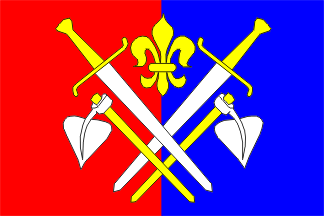
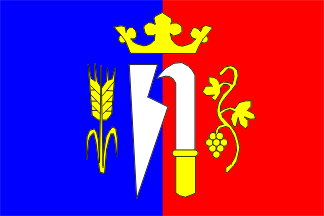
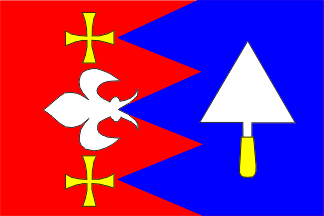
Flag of Drahenice, Czechia;
Flag of Tasovice, Czechia;
Flag of Dolce, Czechia
- HANDSCHYNIE
- A Scottish term, now obsolete, for a miniature square banner.
- HANDSIGNE
- A 16th/17th century variant spelling, now obsolete, of ensign – see
ensign 1)
and ensign 4) (also
ancient 2)).
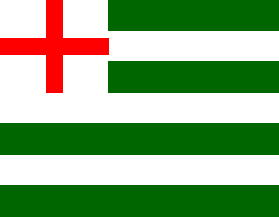
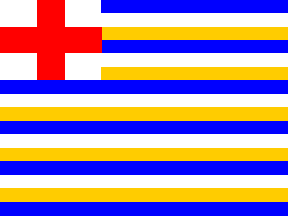
Handsigne/Ensign, English c1590; Handsigne/Ensign,
English c1620
- HANDWAVER (or HANDFLAG)
- A small flag, usually made of either fabric or paper, fitted to a short stick and
intended to be waved by hand (see also flaglet and
table flag).
- HANGING FLAG
- A long vertically orientated flag – originally of Germanic origin and now
characteristic of both German speaking and other Central European countries – a vertical flag –
it is square-ended or swallow tailed, usually consists of the main flag charge
and livery colours (with its first or main colour at the dexter edge) and is specifically designed to be
hung by its top edge from a horizontal pole attached to a building – not to be confused with the
banner as defined herein and the similar (but usually shorter and more elaborately
designed) gonfalon – see banner 2
and the note below
(also
bannerhead,
flag charge,
gonfalon 1),
inner edge,
livery colours,
outer edge,
outrigger flag,
rotated,
vertical flag,
and vertically hoisted flag 1)).
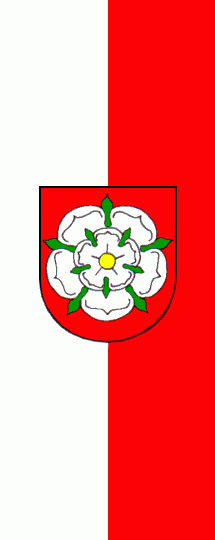
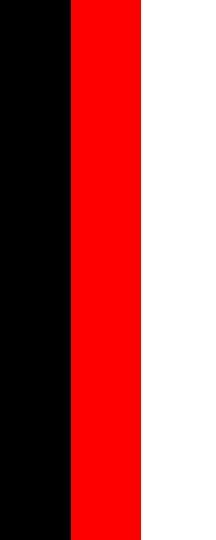
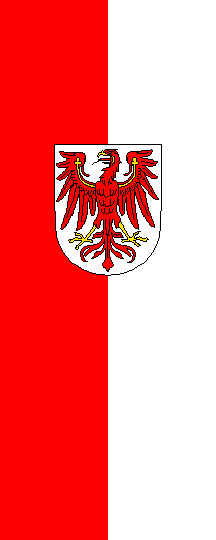
Hanging flags of Rosenheim,
Memmingen and
Brandenburg, Germany
Notes
a) The Editors have adopted strict German vexillological practice in that they have drawn
a precisely defined distinction between a hanging flag and a banner, however:
b) These terms are often
(sometimes officially) regarded as synonymous and are considered interchangeable.
- HANSEATENKREUZ
- See Hanseatic cross.
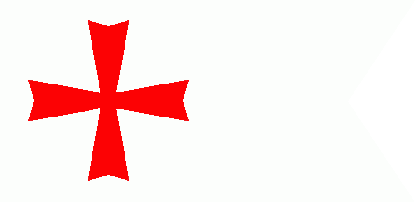
Cavalry Pennant c1814, Lübeck
- HANSEATIC (or HANSA) CROSS
- The term (together with its abbreviation) is translated from the German Hanseatenkreuz
with this being a war-service medal issued by the former Hanseatic cities of Hamburg, Lübeck and
Bremen from 1915–1918, and which is sometimes used to describe a red, cross pattée
of Germanic, particularly (but not exclusively) Hanseatic origin – see
cross pattée (also
cross 2) and
iron cross).
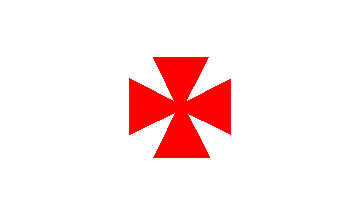
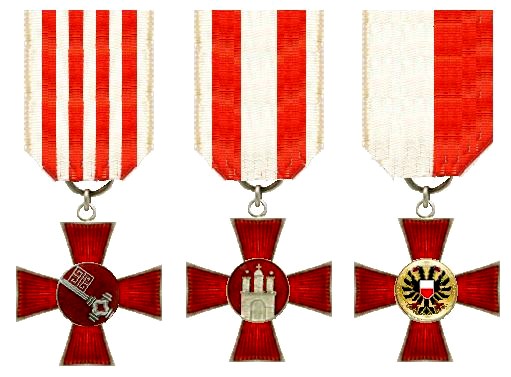
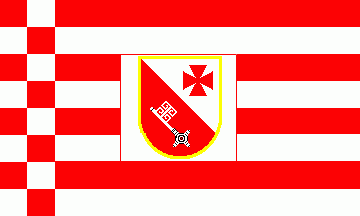
Flag of the Hamburgischer Verein Seefahrt e.V., Germany;
Hanseatic Crosses of
Hamburg, Lübeck and Bremen (Hanseatic Cities);
Flag of Vegesack, Bremen, Germany
Notes
a) The above terms should only be used when the cross pattée
being described is red and/or is of a Hanseatic origin.
b)
Information suggests that this term (describing a cross as defined above) dates from the
early 19th century and the formation of volunteer corps from the former Hanseatic cities who took such a
cross as one of their emblems.
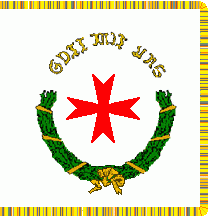
Flag of the Hamburg Citizen’s Militia
1814–1858
- HARDI
- In some systems of Continental European heraldry a term relating to the (usually aggressive) attitude of a
rooster (see also jelloped and wattled 2)).
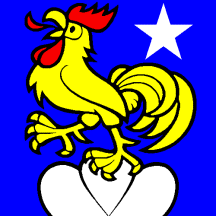
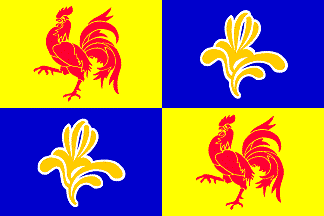

Flag of Malleray, Switzerland;
Flag of French Community Commission of the Region of Brussels-Capital, Belgium;
Flag of Veltheim, Switzerland
- HARNESSED
- 1) In modern heraldry the term that can be used when a domesticated animal (most often a horse) is
shown fitted with its harness – but see 2) below.
2) See harnysed.
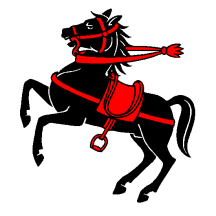
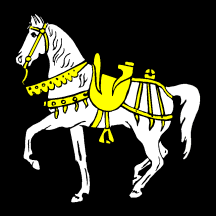
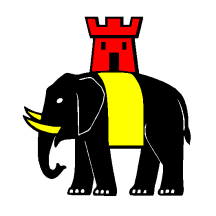
Flag of Seuzach, Switzerland;
Flag of Cressier, Switzerland;
Flag of Hilfikon, Switzerland
- HARNYSED
- In traditional heraldry the term used when a human figure is clad in armour – but see
vambraced
(also armoured and
armed 2), halberd,
harnessed 1) and the note below).
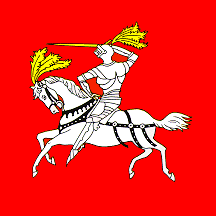
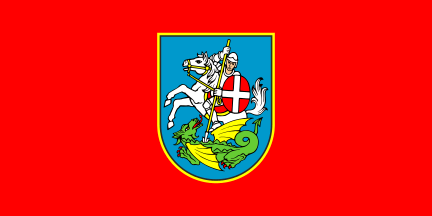

Flag of Collex-Bossy, Switzerland;
Flag of Pag, Croatia;
State Flag of Lithuania
Please note that this is an obsolete spelling of the word harnessed, and should be used when
referring to the harness (or suit of armour) worn in battle during the Medieval period.
- HATA SASHIMONO
- A Japanese phrase covering the generic term flag – see daimyo flags
(also flag 1) and hinomaru).
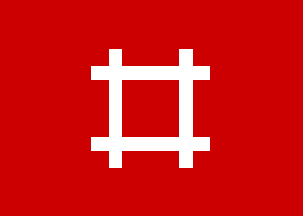
Flag of Ii, daimyo of Hikone 19th c., Japan
- HATCHING
- 1) In heraldry, a widely employed system of lines, dots and slashes used to indicate tinctures on a
monochrome illustration
– the Petra Santa method (see also tinctures and
monochrome 1)).
- 2) In vexillology, as 1) above but also used randomly to give a textural appearance to certain
charges (see also
charge 1)).

From left: Gules, Azure, Vert, Purpure, Sable, Or and Argent
Please note with regard to 1) that this method of depicting tinctures on a black and white
illustration was created in 1638, however, it is suggested that a glossary or dictionary of heraldry be
consulted if full details are required.
- HATCHMENT
- See achievement 2).

Hatchment/Achievement of Arms of the Late Sir Winston Churchill, UK
(Churchill Society)
- HAURIENT (or HAURIANT)
- The heraldic term used when a fish is in the erect position
– hauriant (see also naiant
and urinant).


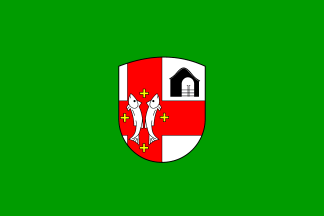
Flag of Nordreisa, Norway;
Flag of Ribnica na Pohorju, Slovenia;
Flag of Thalfang, Germany

.gif)











kc-ki.gif)
740.gif)





























